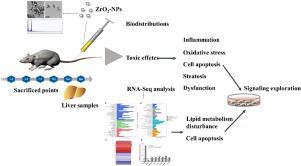当前位置:
X-MOL 学术
›
Process Saf. Environ. Prot.
›
论文详情
Our official English website, www.x-mol.net, welcomes your
feedback! (Note: you will need to create a separate account there.)
Hepatic distribution and toxicity of zirconia nanoparticles in vivo and in vitro
Process Safety and Environmental Protection ( IF 6.9 ) Pub Date : 2021-03-01 , DOI: 10.1016/j.psep.2020.09.021 Ting Sun , Xiangning Liu , Xiaozhen Zhan , Lingling Ou , Renfa Lai
Process Safety and Environmental Protection ( IF 6.9 ) Pub Date : 2021-03-01 , DOI: 10.1016/j.psep.2020.09.021 Ting Sun , Xiangning Liu , Xiaozhen Zhan , Lingling Ou , Renfa Lai

|
Abstract Zirconia nanoparticles (ZrO2-NPs) have been increasingly used in industrial, biomedical and dental materials. Nevertheless, the scientific basis for the toxicological effects of ZrO2-NPs is poorly elucidated, and the understanding of the underlying mechanism is still limited. The hepatic biodistribution and toxicological effects of ZrO2-NPs after a single intravenous administration (20 mg/kg bw) in vivo and the toxicological mechanism toward hepatocytes in vitro were investigated. The liver showed continuous ZrO2-NP accumulation over a 28-d period. Moreover, ZrO2-NPs induced steatosis, functional injury, inflammatory response, and gene alternations in the liver. The main gene altered pathways induced by ZrO2-NP exposure were involved in metabolism, cellular processes, and human diseases. Among these pathways, lipid biosynthesis and metabolism alterations were predominant, and P53 signaling was also identified. Precious gene expression quantification further showed alterations in genes related to lipid biosynthesis and metabolism and cell apoptosis. Meanwhile, the results of the in vitro studies demonstrated ZrO2-NPs induce oxidative stress, lipid accumulation, cell apoptosis and P53-mediated signaling pathway activation in HepG2 cells. This study proves that ZrO2-NPs have impacts on the liver. There is potential concern over the hepatotoxicity of ZrO2-NPs in biomedical applications and occupational exposure through large-scale production.
中文翻译:

氧化锆纳米粒子在体内外的肝脏分布和毒性
摘要氧化锆纳米粒子 (ZrO2-NPs) 已越来越多地用于工业、生物医学和牙科材料。然而,ZrO2-NPs 毒理学作用的科学基础尚不清楚,对潜在机制的理解仍然有限。研究了 ZrO2-NPs 在体内单次静脉内给药 (20 mg/kg bw) 后的肝脏生物分布和毒理学作用以及体外对肝细胞的毒理学机制。肝脏在 28 天的时间内显示出连续的 ZrO2-NP 积累。此外,ZrO2-NPs 诱导肝脏脂肪变性、功能损伤、炎症反应和基因改变。ZrO2-NP 暴露诱导的主要基因改变途径涉及代谢、细胞过程和人类疾病。在这些途径中,脂质生物合成和代谢改变占主导地位,并且还鉴定了 P53 信号传导。宝贵的基因表达定量进一步显示了与脂质生物合成和代谢以及细胞凋亡相关的基因的改变。同时,体外研究结果表明,ZrO2-NPs 在 HepG2 细胞中诱导氧化应激、脂质积累、细胞凋亡和 P53 介导的信号通路激活。该研究证明 ZrO2-NPs 对肝脏有影响。通过大规模生产,ZrO2-NPs 在生物医学应用和职业暴露中的肝毒性存在潜在的担忧。同时,体外研究结果表明,ZrO2-NPs 在 HepG2 细胞中诱导氧化应激、脂质积累、细胞凋亡和 P53 介导的信号通路激活。该研究证明 ZrO2-NPs 对肝脏有影响。通过大规模生产,ZrO2-NPs 在生物医学应用和职业暴露中的肝毒性存在潜在的担忧。同时,体外研究结果表明,ZrO2-NPs 在 HepG2 细胞中诱导氧化应激、脂质积累、细胞凋亡和 P53 介导的信号通路激活。该研究证明 ZrO2-NPs 对肝脏有影响。通过大规模生产,ZrO2-NPs 在生物医学应用和职业暴露中的肝毒性存在潜在的担忧。
更新日期:2021-03-01
中文翻译:

氧化锆纳米粒子在体内外的肝脏分布和毒性
摘要氧化锆纳米粒子 (ZrO2-NPs) 已越来越多地用于工业、生物医学和牙科材料。然而,ZrO2-NPs 毒理学作用的科学基础尚不清楚,对潜在机制的理解仍然有限。研究了 ZrO2-NPs 在体内单次静脉内给药 (20 mg/kg bw) 后的肝脏生物分布和毒理学作用以及体外对肝细胞的毒理学机制。肝脏在 28 天的时间内显示出连续的 ZrO2-NP 积累。此外,ZrO2-NPs 诱导肝脏脂肪变性、功能损伤、炎症反应和基因改变。ZrO2-NP 暴露诱导的主要基因改变途径涉及代谢、细胞过程和人类疾病。在这些途径中,脂质生物合成和代谢改变占主导地位,并且还鉴定了 P53 信号传导。宝贵的基因表达定量进一步显示了与脂质生物合成和代谢以及细胞凋亡相关的基因的改变。同时,体外研究结果表明,ZrO2-NPs 在 HepG2 细胞中诱导氧化应激、脂质积累、细胞凋亡和 P53 介导的信号通路激活。该研究证明 ZrO2-NPs 对肝脏有影响。通过大规模生产,ZrO2-NPs 在生物医学应用和职业暴露中的肝毒性存在潜在的担忧。同时,体外研究结果表明,ZrO2-NPs 在 HepG2 细胞中诱导氧化应激、脂质积累、细胞凋亡和 P53 介导的信号通路激活。该研究证明 ZrO2-NPs 对肝脏有影响。通过大规模生产,ZrO2-NPs 在生物医学应用和职业暴露中的肝毒性存在潜在的担忧。同时,体外研究结果表明,ZrO2-NPs 在 HepG2 细胞中诱导氧化应激、脂质积累、细胞凋亡和 P53 介导的信号通路激活。该研究证明 ZrO2-NPs 对肝脏有影响。通过大规模生产,ZrO2-NPs 在生物医学应用和职业暴露中的肝毒性存在潜在的担忧。











































 京公网安备 11010802027423号
京公网安备 11010802027423号